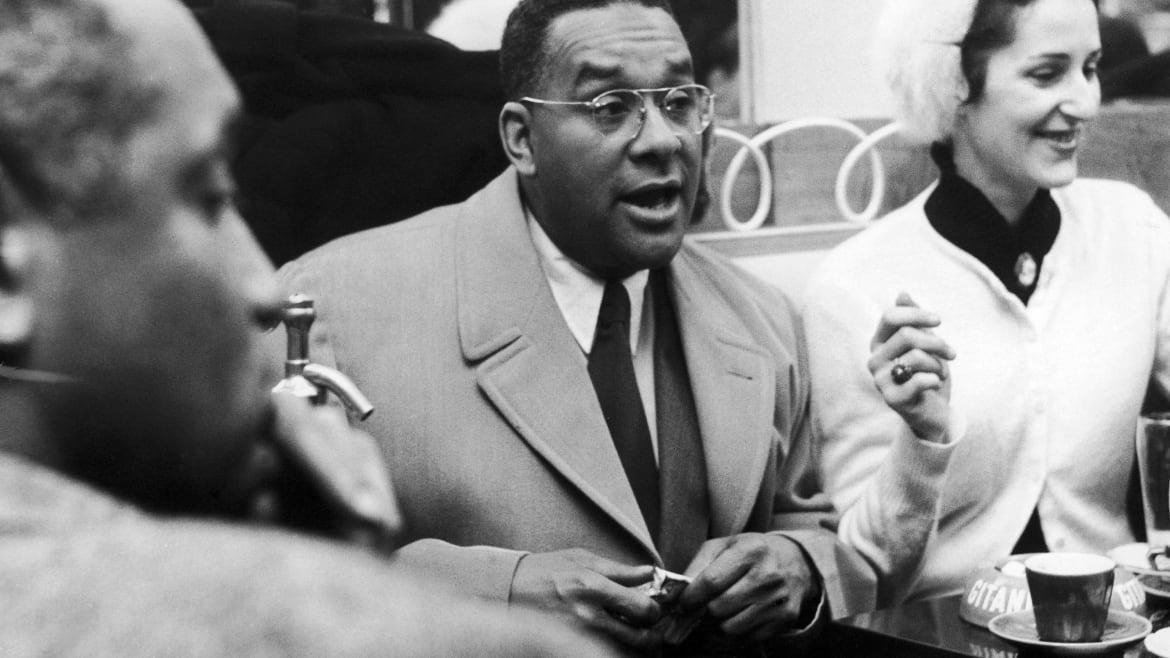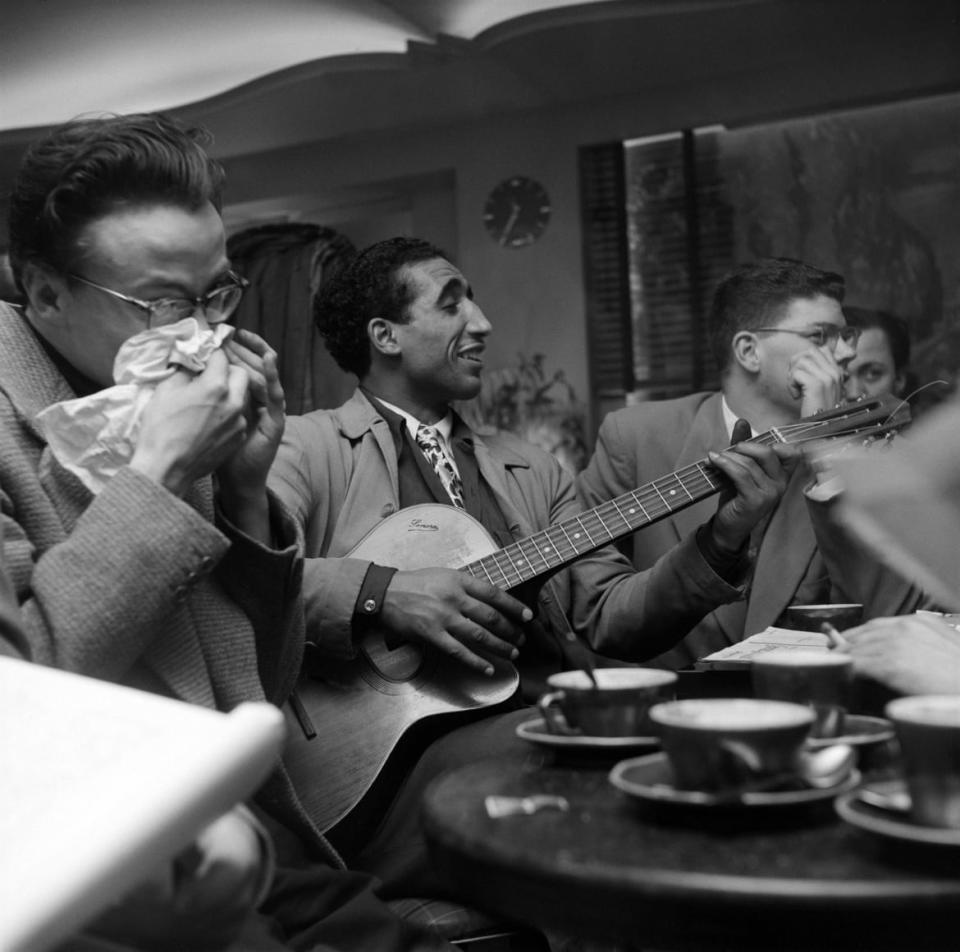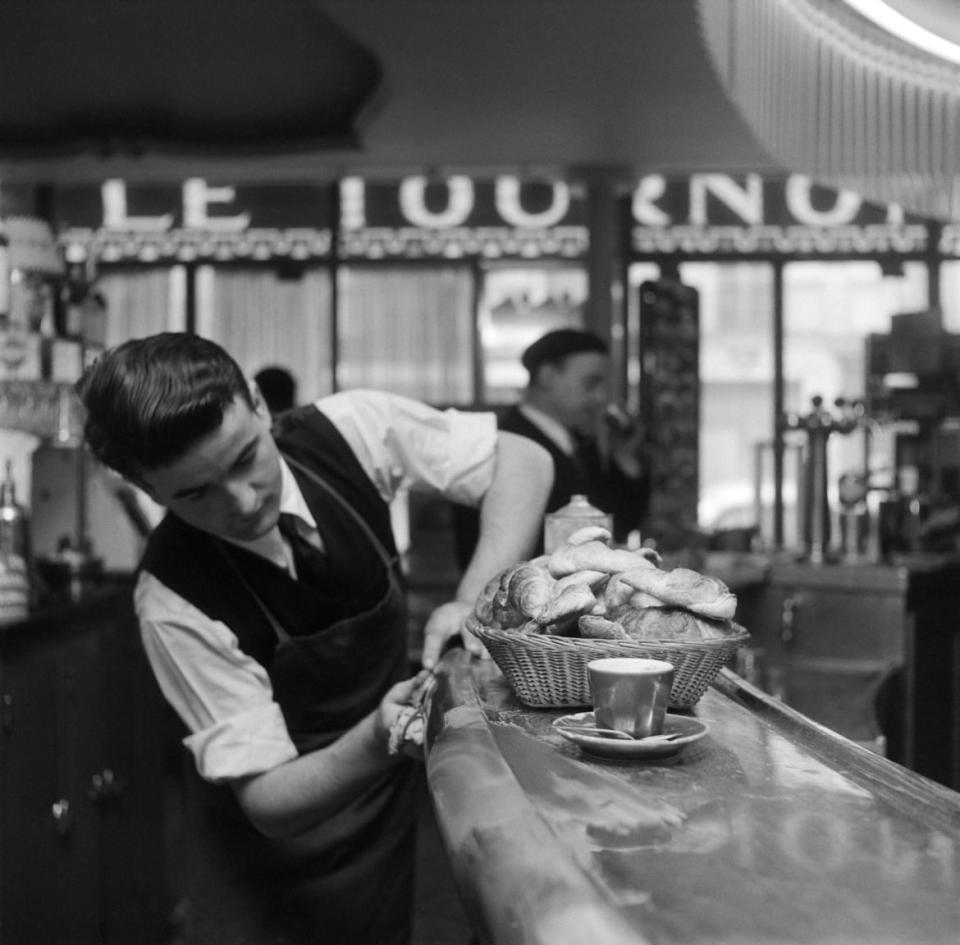Discovering Café Tournon–the Hidden Gem of African American Paris

If you have ever wandered the streets of Paris on a rainy afternoon looking for a reprieve from the hustle of the city, hopefully, you found your way to Café Tournon in the posh 6th Arrondissement.
Just like every other café in the city, you can order a comforting espresso or a glass of cheap Beaujolais wine, but it’s not the drinks that make the establishment special but rather its rich history. For decades, it was a hangout and refuge of African American artists and musicians.
If you engage in a little small talk with one of the waiters, before you know it, you’ll have in your hands framed photos of the Harlem Renaissance painter Beauford Delaney and the legendary jazz bandleader Duke Ellington.

"Parisian cafe in Paris, France in the 1950s - Inside Parisian cafe Le Tournon in Saint Germain des Pres."
The establishment’s beige façade blends in with the classic apartment buildings of the rue de Tournon, a street named for a long-forgotten 16th-century cardinal that leads right to the Palais du Luxembourg. The Palais itself was modeled on a Florentine palace by Marie de Médicis, a Renaissance-era queen of Italian origins, and is now home to the French Senate. This accounts for the extremely (some would say terminally) calm atmosphere of the café, which is now a popular rendezvous spot for neighborhood residents and Senators (whose average age is 64 years old).
But don’t be fooled, the Café Tournon is extremely important to the history of African American expats in Paris. The Bronx-born, Montmartre-settled novelist Jake Lamar remembers rushing there as a young man, looking for the alluring ghosts of the Tournon crowd, including Ellington, and—for him, most important of all—writers like Chester Himes, Richard Wright, and James Baldwin.
“My very first week in Paris, back in 1993, when I entered the Café Tournon, I almost expected to see them all there, through thick clouds of cigarette smoke, sitting at the tables with pints of beer or bottles of red wine,” he told me recently. “Really, some part of me thought they’d be there. Instead, all I saw was a bunch of little old ladies.”
While the crowd may be different, it’s still easy to conjure up the past, since the café itself essentially unchanged, including the moleskin banquets, the zinc-topped bar, and the kitschy murals of the Luxembourg Gardens that are featured in the few known pictures of Tournon’s golden age. The menu hasn’t changed much, either: diners can start with a plate of snails (the famed escargots de Bourgogne) or some bone marrow and pork sausage, followed by a nice côte de boeuf with fresh-cut fries and to finish a traditional “Champagne gourmand” (a glass of Champagne with assorted pastries).
How could the young Baldwin, who arrived in Paris following in Wright’s footsteps, long before becoming famous, afford such delights? Suffice it to say that in post-war Europe, an American dollar was worth a lot and starving artists could enjoy delicious food and wine even when their lodgings and general finances were far from regal.
“It’s hard to overstate how important Paris was to the Black communities all around the world,” explains the novelist and poet Daniel Maximin who came to Paris from his native Guadeloupe as a teenager in the '60s. “It was another New York, a Black and Caribbean capital, a vibrant cultural scene where English, Spanish, and French speakers met up and talked. It was the first destination for anyone coming from New Orleans, Port-au-Prince, or Harlem.”
The pull of Paris was strong for black Americans all throughout the '20s with the likes of Josephine Baker, Langston Hughes, and Sidney Bechet crossing the Atlantic to enjoy the French way of life. And during World War I, 200,000 African Americans worked in several French ports unloading U.S. military boats. After the war, they went back home full of tales of a “deeply different society, with no segregation or lynching,” according to the historian Pap Ndiaye, who is the author of Nylon and Bombs: DuPont and the March of Modern America and teaches at Sciences Po University.
After World War II, Wright was the first to make the journey. As Jake Lamar told me the story, “Wright finally decided to leave the U.S. after his three-year-old daughter was refused access to the restroom of a Fifth Avenue department store. Julia was with a white baby sitter and when the woman behind the store counter saw a little brown-skinned girl walking toward the bathroom, she called out, ‘Oh, no, you can’t take her in there!’ Julia was forced to go outside and pee in the gutter. Wright was furious when he heard about it. Here he was, rich and famous, and yet his three-year-old daughter was treated like a dog. He had already considered leaving the country, but that incident was the last straw.”
In 1946, when Wright got to Paris, family in tow, he found a welcoming committee of the first order: Gertrude Stein, Jean-Paul Sartre, Simone de Beauvoir, and Albert Camus. The city’s literary elite of the Saint-Germain-des-Prés neighborhood were all there, determined to help out the American novelist whom they admired so much.
As Ndiaye points out, the left-wing leanings of the French intellectual elite explain in part their enthusiasm for the Native Son author and his work. “In their eyes, African-Americans were the only ‘good’ Americans, because they were fighting against imperialism and racism, just as the Communist Party did.” Over coffee at another famous Paris café, Les Deux-Magots, Wright and Sartre would discuss how the tragedy of America’s institutionalized racism connected to the core existentialist question: What defines a human being?

"Parisian cafe Le Tournon in Saint Germain des Pres in Paris, France in the 1950s."
“Richard Wright thought there was no racism in France,” explains Jake Lamar. “He lived on the elegant rue Monsieur Le Prince, near the Luxembourg Gardens. He loved the city. He once said there was more freedom in one square block of Paris than there was in the entire United States.”
Café Tournon, which was near Wright’s home, soon became his favorite haunt. It was already famous for being the place where Dizzy Gillespie’s jazz band made its Paris debut. Yet Wright's first encounter with the young Baldwin, who crossed the Atlantic in 1948, happened at the Brasserie Lipp, eternal purveyor of hardboiled eggs covered in mayonnaise and another favorite of the Saint-Germain crowd.
Some years later, in May 1953, Wright and Baldwin got into an argument that has now become infamous in the story of their oedipal relationship, on the second floor of the Deux Magots under the eyes of Chester Himes, a wonderful crime writer who was bemused at the whole scene. “In the arena of fame, there was space for only one African-American writer” is how Lamar sums it up.
While the neighborhood and the clientele have changed over the years, the Café Tournon is still a great place to meet a friend for a drink on a rainy day. The most Parisian of all pleasures.
Get our top stories in your inbox every day. Sign up now!
Daily Beast Membership: Beast Inside goes deeper on the stories that matter to you. Learn more.

